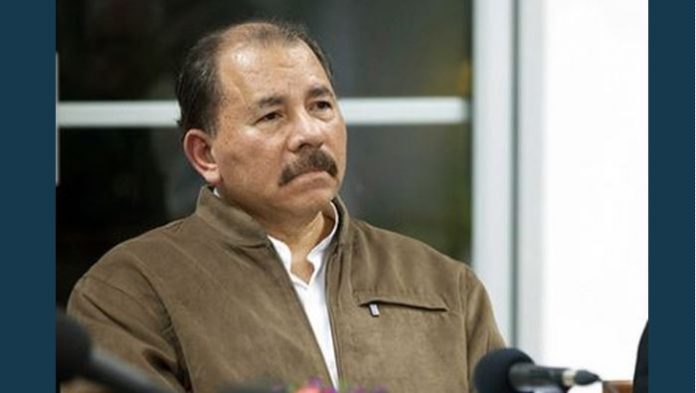MANAGUA, Nicaragua, May 31 (UPI) — Across Nicaragua, protesters are blocking highways and streets to send a message to the government after more than 70 protesters were allegedly killed by police last month.
The tranques vary in size, from about 4-foot-high walls on Managua avenues that slow car traffic, to piles of metal and burning tires on vital highways that delay trucks transporting food staples to other parts of the country, causing food and medicine shortages in some regions.
Protesters, whom authorities have allowed to maintain the tranques without interference in most — but not all — cases, say they plan to block roads until they get justice for the more than 70 people who were killed during protests against the government’s plan to increase social security taxes and cut benefits.
What that justice entails depends on who is describing it, but generally consists of some iteration of Nicaraguan President Daniel Ortega leaving office.
“The tranques will stay up until he is gone because that’s the only way we will survive,” said a 19-year-old demonstrator in Managua who gave his name as “S-1.”
“We have to show that the people are in charge of Nicaragua and this pressure shows that,” he said. “The government wants to say that people are hurting because of the tranques but how can they talk when they’re the ones who are murdering the people?”
One car at a time
In Managua, Nicaragua’s largest city, the roadblocks are usually walls made of stacked, gray stones. They’re manned by masked teenagers — mostly boys but a few girls — as young as 15 and wielding homemade mortar guns. These walls are up at streets and roundabouts around the city. During the day, vehicles may pass through one at a time, with the teenage guards directing traffic. At night, typically around 7 p.m., the tranques are closed until the next morning.
“Traffic is slowed down but people can get to where they need, either through the tranque or by going around,” S-1 said. “That’s why you don’t see people complaining because most of the people are with us and they support us.”
On the highway into Masaya, a large roadblock is periodically up on one of the main arteries of the nation. The tranque guards here are older — in their 20s and 30s — and they block the road with burning tires and car hoods propped up with wooden boards.
Inside the city’s downtown area, a popular tourist destination before the current protests, a series of unguarded walls have been put up every few blocks along the main thoroughfare. Like in Managua, there’s enough room for one car at a time to go around.
“Those are there to protect us from the police. If they try to attack again, they’ll be slowed down and we have time to prepare,” said 50-year-old Manuel Lopez of Masaya.
Ortega ‘no longer a Sandinista’
Much of the violence in April occurred in Masaya — at least three protesters were killed and many more injured, allegedly by police. On the same street with the periodic roadblocks, a memorial has been set up to commemorate the slain protesters. A few feet away, walls are covered in anti-government graffiti and vendors sell t-shirts that honor the student protesters with what has become the protest movement’s unofficial slogan: “Que se rinda tu madre!” or “Let your mother submit!”
The phrase comes from Nicaraguan poet and Sandinista guerilla Leonel Rugama, who is rumored to have said it while fighting soldiers of former Nicaraguan dictator Anastasio Somoza just before they killed him in 1970.
A protest movement against Ortega, the longtime face of the Sandinistas, using a slogan uttered by another iconic Sandinista fighting dictatorship, is done on purpose.
“Ortega no longer represents the Sandinista ideals of the ’70s and ’80s that was about supporting the people,” said a protester who asked not to be named. “He’s no longer a Sandinista. He’s an Ortegista.”
Delays and discontent
In the less populated regions of the country, the highway tranques are bigger and have stricter rules about passage. They’re also manned by people of various ages, many of whom are not the university students who have received most of the media attention. These people are known as the campesinos, many of whom have been organized since 2015 when they began protesting the government over its plan to build an inter-oceanic canal through their land.
Las Maderas, about 32 miles northeast of Managua, is a major passageway for bus passengers traveling to the eastern part of the country. But since May 22, the tranque there has prohibited buses from passing through. Passengers are allowed to pass through on foot and bus companies have adapted by having another bus ready on the other side.
In January, the first road connecting Managua and Bluefields, the largest city on Nicaragua’s Caribbean coast, was opened in January — a historic moment for the country. But the road goes through Nueva Guinea, where another major tranque has been set up, clogging a major artery for getting goods and passengers to and from the Caribbean coast. Last week, buses from Bluefields to Managua were stopped for up to 30 hours.
Many Nicaraguans say they the need to protest the government and see the tranques as a necessary inconvenience. But others question the value of burdening the lives of the people to protest the government.
“Okay, build the tranques — but why put them around the people? Put them around El Carmen,” said 42-year-old restaurant worker Ivan Santoy, referring to the Managua neighborhood where the Nicaraguan president lives. “The government doesn’t work but the people have to.”
Pro-government media channels have also seized on the discontent over tranques.
“Streets in Leon are blocked by right-wing coup leaders who are stealing the peace of the Nicaraguan people,” Nicaragua’s Channel 13 posted on Instagram with a photo of a tranque.
There have also been reports of tranques set up by “pirates,” who threaten people unless they pay a fine to pass.The government says this is the true face of the protesters, calling them “right-wing vandals.” But protesters say these tranques are put up by Sandinista turbas, referring to pro-government gangs, to portray them in a negative light and spread propaganda.
Empty shelves, rising prices
In the less populated eastern part of Nicaragua, people have been feeling the impact of the tranques in serious ways.
David Zywieck, the Bishop of Siuna, a mining town in northeast Nicaragua, said pharmacies are short on medicine, building materials like tools and cement are in short supply and people are running out of sugar, flour, milk and cooking oil. Gasoline has also become scarce and more expensive.
Miners have been directly impacted. Many work freelance, Zywieck said, and are unable to get dynamite to do their jobs.
“These are things that are affecting people’s health and economy,” Zywieck said.
As for whether people of Siuna support the tranques, Zywieck says it’s “mixed.”
“There’s no consensus, but it’s hurting people’s pockets and their way of life,” he said. “How can you support your family?”
S-1 said he sympathizes with people in other parts of the country who are impacted by the roadblocks.
“But that has been a problem before the tranques and the government didn’t care,” he said. “It took hurting private business profits for them to notice.”







